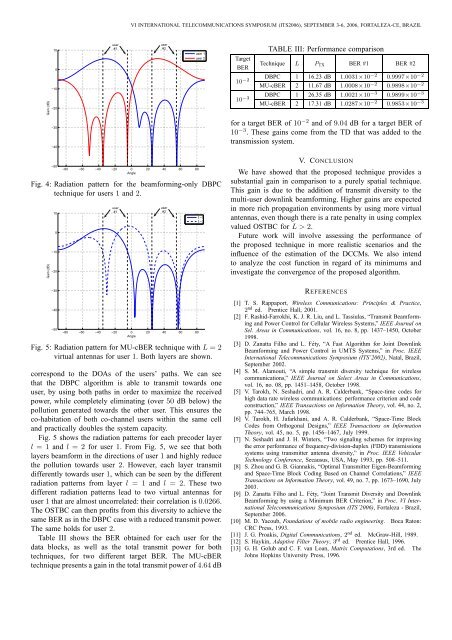TH`ESE - Library of Ph.D. Theses | EURASIP
TH`ESE - Library of Ph.D. Theses | EURASIP
TH`ESE - Library of Ph.D. Theses | EURASIP
You also want an ePaper? Increase the reach of your titles
YUMPU automatically turns print PDFs into web optimized ePapers that Google loves.
VI INTERNATIONAL TELECOMMUNICATIONS SYMPOSIUM (ITS2006), SEPTEMBER 3-6, 2006, FORTALEZA-CE, BRAZIL100user#1user#2user 1user 2TargetBERTABLE III: Performance comparisonTechnique L P TX BER #1 BER #2DBPC 1 16.23 dB 1.0031×10 −2 0.9997×10 −210 −2 MU-cBER 2 11.67 dB 1.0008×10 −2 0.9898×10 −2Gain (dB)−10−20DBPC 1 26.35 dB 1.0021×10 −3 0.9899×10 −310 −3 MU-cBER 2 17.31 dB 1.0287×10 −2 0.9853×10 −3−30−40for a target BER <strong>of</strong> 10 −2 and <strong>of</strong> 9.04 dB for a target BER <strong>of</strong>10 −3 . These gains come from the TD that was added to thetransmission system.−50−80 −60 −40 −20 0 20 40 60 80AngleFig. 4: Radiation pattern for the beamforming-only DBPCtechnique for users 1 and 2.Gain (dB)100−10−20user#1user#2l=1l=2V. CONCLUSIONWe have showed that the proposed technique provides asubstantial gain in comparison to a purely spatial technique.This gain is due to the addition <strong>of</strong> transmit diversity to themulti-user downlink beamforming. Higher gains are expectedin more rich propagation environments by using more virtualantennas, even though there is a rate penalty in using complexvalued OSTBC for L > 2.Future work will involve assessing the performance <strong>of</strong>the proposed technique in more realistic scenarios and theinfluence <strong>of</strong> the estimation <strong>of</strong> the DCCMs. We also intendto analyze the cost function in regard <strong>of</strong> its minimums andinvestigate the convergence <strong>of</strong> the proposed algorithm.−30−40−50−80 −60 −40 −20 0 20 40 60 80AngleFig. 5: Radiation pattern for MU-cBER technique with L = 2virtual antennas for user 1. Both layers are shown.correspond to the DOAs <strong>of</strong> the users’ paths. We can seethat the DBPC algorithm is able to transmit towards oneuser, by using both paths in order to maximize the receivedpower, while completely eliminating (over 50 dB below) thepollution generated towards the other user. This ensures theco-habitation <strong>of</strong> both co-channel users within the same celland practically doubles the system capacity.Fig. 5 shows the radiation patterns for each precoder layerl = 1 and l = 2 for user 1. From Fig. 5, we see that bothlayers beamform in the directions <strong>of</strong> user 1 and highly reducethe pollution towards user 2. However, each layer transmitdifferently towards user 1, which can be seen by the differentradiation patterns from layer l = 1 and l = 2. These twodifferent radiation patterns lead to two virtual antennas foruser 1 that are almost uncorrelated: their correlation is 0.0266.The OSTBC can then pr<strong>of</strong>its from this diversity to achieve thesame BER as in the DBPC case with a reduced transmit power.The same holds for user 2.Table III shows the BER obtained for each user for thedata blocks, as well as the total transmit power for bothtechniques, for two different target BER. The MU-cBERtechnique presents a gain in the total transmit power <strong>of</strong> 4.64 dBREFERENCES[1] T. S. Rappaport, Wireless Communications: Principles & Practice,2 nd ed. Prentice Hall, 2001.[2] F. Rashid-Farrokhi, K. J. R. Liu, and L. Tassiulas, “Transmit Beamformingand Power Control for Cellular Wireless Systems,” IEEE Journal onSel. Areas in Communications, vol. 16, no. 8, pp. 1437–1450, October1998.[3] D. Zanatta Filho and L. Féty, “A Fast Algorithm for Joint DownlinkBeamforming and Power Control in UMTS Systems,” in Proc. IEEEInternational Telecommunications Symposium (ITS’2002), Natal, Brazil,September 2002.[4] S. M. Alamouti, “A simple transmit diversity technique for wirelesscommunications,” IEEE Journal on Select Areas in Communications,vol. 16, no. 08, pp. 1451–1458, October 1998.[5] V. Tarokh, N. Seshadri, and A. R. Calderbank, “Space-time codes forhigh data rate wireless communications: performance criterion and codeconstruction,” IEEE Transactions on Information Theory, vol. 44, no. 2,pp. 744–765, March 1998.[6] V. Tarokh, H. Jafarkhani, and A. R. Calderbank, “Space-Time BlockCodes from Orthogonal Designs,” IEEE Transactions on InformationTheory, vol. 45, no. 5, pp. 1456–1467, July 1999.[7] N. Seshadri and J. H. Winters, “Two signaling schemes for improvingthe error performance <strong>of</strong> frequency-division-duplex (FDD) transmissionssystems using transmitter antenna diversity,” in Proc. IEEE VehicularTechnology Conference, Secausus, USA, May 1993, pp. 508–511.[8] S. Zhou and G. B. Giannakis, “Optimal Transmitter Eigen-Beamformingand Space-Time Block Coding Based on Channel Correlations,” IEEETransactions on Information Theory, vol. 49, no. 7, pp. 1673–1690, July2003.[9] D. Zanatta Filho and L. Féty, “Joint Transmit Diversity and DownlinkBeamforming by using a Minimum BER Criterion,” in Proc. VI InternationalTelecommunications Symposium (ITS’2006), Fortaleza - Brazil,September 2006.[10] M. D. Yacoub, Foundations <strong>of</strong> mobile radio engineering. Boca Raton:CRC Press, 1993.[11] J. G. Proakis, Digital Communications, 2 nd ed. McGraw-Hill, 1989.[12] S. Haykin, Adaptive Filter Theory, 3 rd ed. Prentice Hall, 1996.[13] G. H. Golub and C. F. van Loan, Matrix Computations, 3rd ed. TheJohns Hopkins University Press, 1996.
















